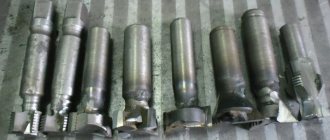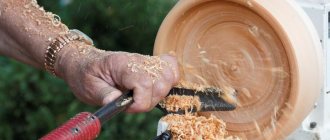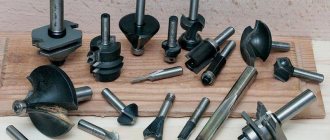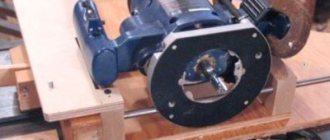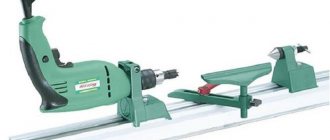The choice of cutter type for a machine depends on the material being processed: 1-flute cutters for CNC machines are suitable for milling “soft” materials: soft plastics (plexiglass, acrylic, PVC, plexiglass, foam plastics), wooden materials (wood, fiberboard, chipboard ), sandwich panels (aluminium/plastics) benefit from being sharp. Since here the problem of faster dulling is preferable to the risk of clogging and breakage of the cutter.
This type of cutter is mainly used by advertising and prototyping industries for quick cutting of materials in cases where the quality of the end of the surface being processed is not so important. However, the depth and length of one flute produces long chips, which prevents the cutter from clogging, increasing its durability.
2-flute cutters for CNC machines are suitable for milling hard materials MDF, Plywood, plastics (plexiglass, acrylic, PVC, plexiglass, foam), sandwiches (aluminum / plastics).
A spiral cutter with two or more passes is used for processing with the formation of smaller chips and with a large material removal in one pass. The number of teeth and the depth of the grooves ensure grinding. When using cutters with a large number of passes, you can achieve greater cleanliness of the machined surface.
The spiral double-flute round cutter allows you to get the least rough surface due to less vibration during the cutting process. This tool is used for applying U-shaped engraving (for example, text) on the surface of the material, and is also used in the final or preliminary processing of three-dimensional objects (depending on the size of the smallest relief elements). When finishing hard wood with such a cutter, the surface turns out polished and does not require additional finishing. Spiral cutters are also used for preliminary and final (depending on the geometry of the surface being processed) processing of 3D objects and various shapes.
The most common are cutters with chip removal upwards. When working with a milling cutter that removes chips upward, lint may be present on the surface of the material being processed. In order to obtain a clean surface when cutting a slotted thread, you can use cutters that remove chips to the bottom, which combine right rotation and a left spiral thread, which prevents the appearance of lint on the surface. When processing laminated materials, compression cutters are used, which make it possible to obtain a chip-free surface, preserving the facing material.
Spherical, or ball, cutters for CNC machines are used for 3D processing. They process wood, plastic, steel, non-ferrous metals (copper, aluminum, duralumin, brass, etc.). These cutters allow you to obtain a surface with less roughness due to less vibration during the cutting process.
Double-start conical cutters for CNC machines are used to work with workpieces made of wood, chipboard, MDF, plastics, model wax and some non-ferrous metals. Double-flute conical cutters are ideal for machining high reliefs in one step without roughing. Thanks to the conical shape, the cutters have high strength with a small diameter of the cutting tip of the cutter.
The cutters are made of tungsten carbide with the addition of hardening impurities and coated with AlTiN (aluminum titanium nitride).
Setting up a taper cutter in ArtCAM is described in the article “Creating a taper cutter tool in ArtCAM”
Milling cutters with a cutting part in the form of a fishtail, when milling through, prevent the appearance of unevenness, chips, and burrs on the back side of the material. The deep groove allows high feed rates to be maintained during high-speed material processing. Due to the geometry of the blade, vibrations are minimized, and the geometry of the cutter contributes to the effective ejection of chips from the cutting zone.
The conical engraver is used for processing small 3D relief elements and for engraving on the surface of materials (ABS, PVC, wood, plexiglass).
Differences between a router and an engraver An engraver is a simple tool, split in half by a cylinder, followed by a back grind. The shape may vary; the most common are triangular. Unlike milling cutters, they do not have a spiral chute to drain chips.
The main difference between Chinese cutters and European ones is their resource, measured in linear meters or machine operating hours. Since the cost of European cutters is usually 2-3 times higher than the cost of Chinese ones, the benefits are quite tangible. When considering a metalworking option, it would be useful to check the accuracy of the cutter. As a rule, factories producing metal milling cutters in Europe also have their representative offices in China. If you take non-brand Chinese cutters, then you need to carefully look at the sharpening angle, the depth of the groove, and it is advisable to ask what alloy they are made of. HSS coated cutters The life of HSS coated cutters is significantly increased. For example, titanium nitride (TiN) increases service life by six times. Titan-Nitrid is significantly stiffer than HSS and also stiffer than HM. With Titan-Nitrid coating, HM tools also last longer, although the difference in hardness is negligible. The coverage has a more significant effect on the number of revolutions and feed. It can be increased and thus the processing time can be shortened. When milling aluminum, TiN prevents the dreaded baking of aluminum in the cutter. The coating acts like Teflon in a frying pan (the chips slide).
Three-flute or three-flute cutters.
Three-flute spiral end mills are used for milling, cutting, grooving on hard materials, roughing and semi-finishing steels, including stainless steels. Three cutting edges provide higher quality of the machined surface than 2- and single-flute cutters. Their main advantage is high rigidity while maintaining good chip removal characteristics from the cutting zone.
You can familiarize yourself with the cutting modes on CNC milling machines here.
Types of cutters for a wood router
In order not to make a mistake when choosing a cutter, you need to know about their classification. So, there are five types of tools we are considering (this classification is based on such a criterion as shape):
1. Disk. 2. End. 3. Angular. 4. End. 5. Shaped.
The first cutters, the disc type, were designed to make a variety of recesses. They can be called multifunctional, since they are capable of performing not one, but several tasks - it all depends on the design features, more precisely, the number and location of the edges.
The second cutters, the end-face type, are best suited if you are dealing with a thin and smooth surface. They look like a cylinder, the edges are located at the ends.
Third cutters, angular type, are indispensable for turning edges. They have two edges placed at different angles relative to each other.
The fourth cutters, end-type, make it possible to work with all axes. As a rule, end mills are diamond cutters.
Fifth cutters, the shaped type, are unusual and are used for unique, difficult workpieces. Shaped type cutters are distinguished by high technical characteristics, as they are used in final processing. The cut is obtained without any errors. We've sorted out the types, now let's move on to the types of cutters for a wood router.
What material needs to be processed?
Processing wood, plastic, metal and other materials determines the requirements for the hardness of the cutter. The denser the material being processed, the greater the hardness of the tool. Cutters made from a high-quality alloy with a high HRC (Rockwell hardness) value are capable of cutting non-ferrous metals and steel, but accordingly have a higher price. It is not economically feasible to use them for processing soft materials; in addition, for different materials, the cutting edges are sharpened at different angles.
Milling cutters for metals and steel often have a special protective coating to ensure long-term wear resistance of the tool. Most often this is AlTiN - a high-tech, very hard layer of aluminum titanium nitride.
Types of wood cutters by purpose, processing, design and material
Based on the area in which cutters are used, they are:
1. For preliminary (rough) processing. 2. For drilling holes. 3. For milling in places where maximum care is required. 4. To create artistic accents. 5. For final (finishing) processing.
The first cutters, for preliminary (roughing) processing, carry out operations such as cutting, cutting, removing a thick layer, and giving the initial shape.
The second cutters, for drilling holes, are used to make a variety of cuts.
The third cutters, for milling in places where maximum accuracy is necessary, are used for turning corners and edges.
The fourth cutters, for creating artistic accents, allow you to create the most real works of art.
And thanks to this type of wood cutters, for final (finishing) processing, the object becomes complete. All that remains is to brush off the shavings.
According to processing, cutters are divided into ten groups:
1. With one pass. Separate the chips in an upward direction. With their help, products made of plastic and other substances with a similar, viscous structure are milled. 2. With two passes. The chips are also removed in an upward direction. They are chosen for infusible and lightweight materials, including wood. 3. With three and four passes. The chips also fly up. They are preferred if the task is to complete a large volume of work in a short time. 4. With cutting of chips in a downward direction. They are used for very small parts and for cutting several sheets at a time. Plus - pressure from above. 5. "Corn". Suitable for fiberglass and all other hard materials. 6. With straight blades. Used for cutting plywood and all other multi-layer materials. 7. With a spherical tip. Designed to give an object relief and create a 3D pattern on it. 8. Engravers. It is easy to understand that products are engraved with them. 9. Compression. They process wood of those species that are susceptible to mechanical damage (chips, cracks) and the appearance of fluff. 10. Shaped. They form shaped surfaces.
By design, cutters can be:
1. Whole. 2. Welded. 3. Soldered. 4. Teams.
The first, solid cutters are 100% made from the same material.
The second, welded cutters, are made of two materials: the tail part is made of one, and the cutting part is made of another, after which they are connected by welding.
In the third, brazed cutters, the cutting part is attached by soldering.
The fourth, prefabricated cutters, have fasteners.
Milling cutters are produced from:
1. High speed steel. 2. Hard metal alloys. 3. Metal ceramics, etc.
Type of processing: finishing or roughing?
As a rule, roughing involves significant material removal. At the same time, no high demands are placed on the cleanliness of the resulting surfaces. For efficient rough milling, both cutters with a flat end (EndMill) and with a spherical end (BallNose) are used. The roughing tool must provide a high sampling speed, which means its dimensions should be limited only by the sizes of the smallest elements (cavities or protrusions) on the workpiece.
Finishing requires a cutter that produces smooth surfaces during processing. Depending on the geometry of the part, EndMill or BallNose cutters are also used here.
Separately, it is necessary to say about cutters for 3D processing. This group also includes universal cutters capable of both roughing and finishing. As a rule, these are V-shaped cutters with a spherical end.
The more cutting edges a cutter has, the higher the feed rate available to it, which means less time is required to process the part.
Double-flute cutters are considered suitable for most applications. They have high processing speeds and cleanliness of the resulting surfaces.
How to choose cutters for a wood milling machine?
Let's summarize. The most important thing you should pay attention to when choosing cutters is, of course, technical characteristics. Namely:
- type of cutting tool - disk, end, angular, end, shaped;
- type of cutting tool for its intended purpose - for preliminary (roughing) processing, for drilling holes, for milling in places where maximum accuracy is necessary, for creating artistic accents, for final (finishing) processing;
- type of cutting tool for processing - with one pass, with two passes, with three and four passes, with cutting chips downwards, “corn”, with straight blades, with a spherical tip, graphers, compression, shaped;
- type of cutting tool by design - solid, welded, brazed or assembled;
- type of cutting tool by material - made of high-speed steel, hard metal alloys, metal-ceramics, etc.
- availability of additional functions;
- voltage at which the CNC machine operates.
Also important:
- cutting tool class - for beginners or professional;
- specifics of the workplace;
- manufacturer's warranty.
Attention! Wood cutters cannot be used for processing metal and, especially, products made from abrasive materials. The fact is that wood is easier to shape and cutters for processing metal and abrasive materials operate using a different technology.
We hope that the information we have prepared about the types of wood cutters for CNC machines will be enough for you to buy a cutting tool yourself.
These articles may also be of interest to you:
- How to remove a stuck bit from a router
- Lathe attachment - a lathe made from a drill
- We make gifts and souvenirs using pyrography
- Attachments, nozzles and accessories for drills
General information
Milling cutters for various types of processing differ in the shape of the cutting edges and methods of sharpening. Backed ones have a curved shape and frontal sharpening; They are used when working with profiles. Pointed ones with a straight profile are used for drilling; they are sharpened on the front or back sides. There are cutters with two cutting edges. This design makes it possible to make tools and processing cheaper, increase work speed and improve the quality of the finished product.
Over time, the cutting edge of the tool becomes dull and wears out. To avoid frequent replacement, cutters are made from high-strength alloys with a long service life.
Take the test
What should you pay attention to when choosing a cutting tool?
First of all, the type of workpiece to be processed (surface hardness) should be taken into account. This directly affects the choice of tool: models with tungsten, molybdenum additives (high-speed steel), or carbide versions. It is important to understand that the latter is a very expensive pleasure. In addition, they are highly specialized (adapted for a specific task).
The following is the answer to the question of what exactly this tool is supposed to do:
- perform rough processing (cut away the surface layers of the material, carry out the initial formation of a model from a workpiece, its cutting or cutting);
- mill grooves (grooves, depressions, grooves, recesses);
- carry out high-precision processing of the edges of the workpiece and its corner parts;
- carry out fine finishing (the optimal solution for this is to use a diamond-coated tool);
- create flat and three-dimensional images.
Procedure on the machine
This order looks like this:
- First you need to load the device into the mechanism magazine.
- Linking a milling machine. All equipment has different lengths, therefore operations are carried out whose purpose is to notify the machine about the location of points in space. Sometimes it is necessary to configure all operating parameters in advance using macro variables so that the binding sensors are used correctly.
- Linking the product to zero, namely, it is necessary to set up a separate coordinate system using a milling cutter or using manual and automatic sensors.
Requirements for this tool
Machines with a computerized control system operate accurately and at high speed, but require careful equipment. To process metal, wood, synthetics and composite materials with different hardness coefficients, cutters with a certain sharpening angle of the cutting edge are needed.
There are factors that influence the result of work:
- the strength of the product itself and the ability to withstand loads;
- the location of the blades in the cutter and their geometric shape;
- wear resistance, allowing the tool to maintain its original sharpening for a long time;
- minimal vibration during the production process.
There is a design variety of cutters for CNC; they are made exclusively from special grades of hardened steel. But there are only two technologies:
- Specialists produce serial tools from a single piece, using high-speed hard steel for this. Among the main advantages are precise execution, guarantee of rigidity, and the ability to work with maximum load.
- The steel body, a hard alloy with a fine-grained structure, is soldered to reproduce the complex geometry of the cutting edge. Scope of application – production of tools (shaped, diamond or large-sized), cutters for woodworking (hand tools).
Milling cutters intended for the production of doors are divided into two main categories.
The first includes sets of cutters, which are, in fact, universal and suitable for the manufacture of almost any door. The second includes those kits that are designed to perform processing work on the so-called door trim. This set includes six different cutters and with its help it is possible to make not only straight, but also arched openings.
Universal cutters are great for a wide range of tasks, for example, for making windows and milling surfaces for fittings. Such kits usually include five cutters, however, their exact number depends directly on the complexity of the work being performed.
